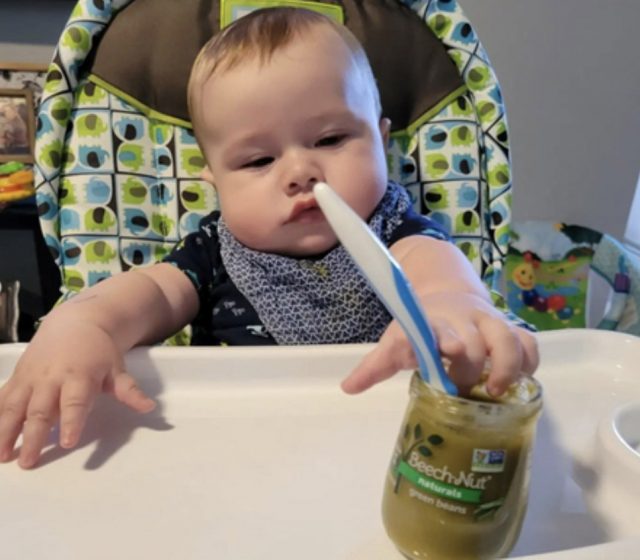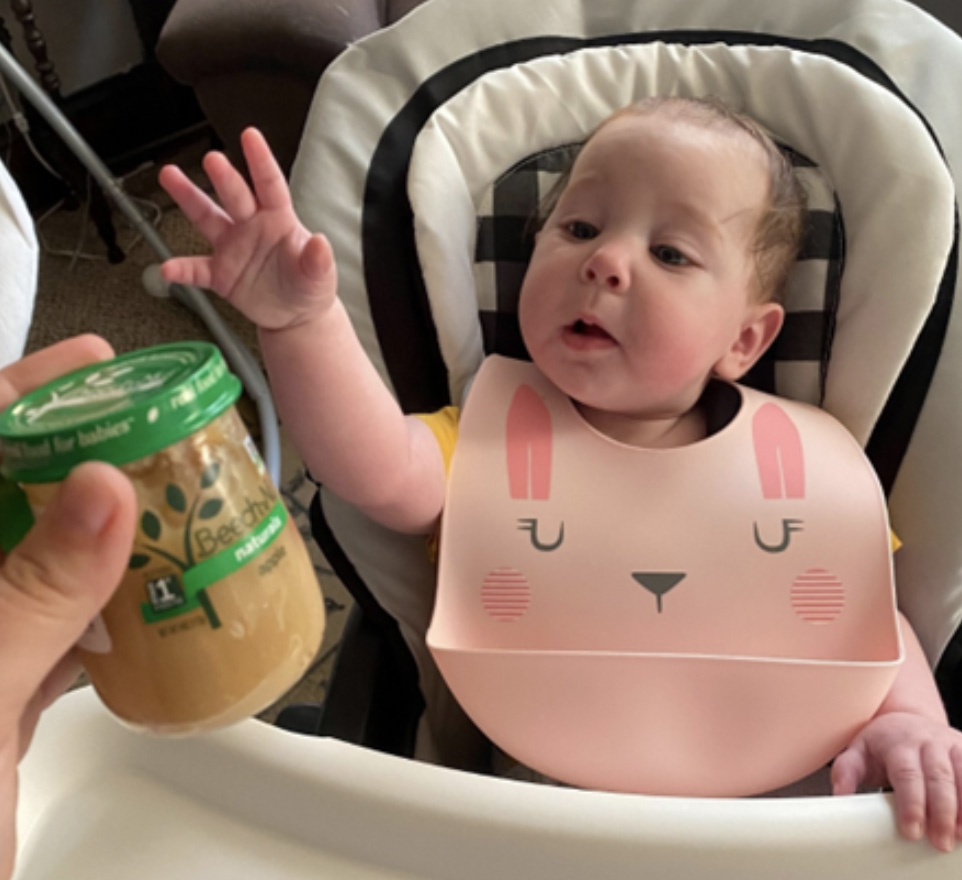Beech-Nut baby food is known for producing quality, natural, and organic products for feeding infants and toddlers. In the following article, the team at Beech-Nut discusses responsive feeding guides, how to feed a baby the right amount, and how to adapt portions as babies age. Additionally, they’ll provide some helpful tips on transitioning a baby from liquid to solid foods. Many parents are more comfortable with a strict feeding schedule and predetermined amounts of food per feeding. Others feel this type of feeding routine is a lot more convenient, too. Unfortunately, this might not be what is best for baby. A set feeding schedule is not ideal for growing babies. Beech-Nut baby food reports that a new technique called, “responsive feeding,” is a great way to feed your baby the appropriate amount of food each day. Watching for signs of hunger and fullness, while reacting appropriately to those cues, will help your baby eat the right amount. Your baby’s age will also play a significant role in how much they should eat.
Below, Beech-Nut baby food dives deeper into responsive feeding techniques:
How to Use the Responsive Feeding Technique to Feed Your Baby
It sounds simple, but many parents still struggle with feeding decisions, as daily milk or formula intake can vary with age, growth spurts, and factors, such as teething, that may reduce a baby’s appetite. Unless a pediatrician has recommended a set feeding schedule for a specific reason, parents should be looking to their child to know when they need to be fed and how much to give them at a time. Beech-Nut baby food says that this on-demand, baby-first style of feeding is called “responsive feeding.” Responsive feeding is exactly what it sounds like: providing and removing food in response to a baby’s cues. From the minute a baby is born, he or she can self-regulate his or her own food intake. A parent simply needs to follow baby’s own cues to let them eat when they want and how much they want. If a baby appears hungry, he or she should be fed. When feeling full, he or she should be allowed to stop eating. The days of force-feeding and strict schedules are over! The responsive feeding technique, therefore, relies heavily on a parent’s ability to recognize and understand the signs of hunger and fullness in a child.
Beech-Nut Baby Food on How to Tell When a Baby Is Hungry
Beech-Nut baby food agrees that learning the hunger cues of one’s child is a shared experience of all new parents. Babies present hunger in a variety of ways. No two babies will express themselves in the same way. Crying is one of the easiest ways to know a baby is hungry, but there are also subtle hunger cues to watch for to see that baby gets fed in a timely manner.
Signs of hunger in a baby can include, but are not limited to, the following:
- Rooting (turning head looking for a breast or bottle)
- Fussiness
- Opening the mouth and/or sticking the tongue out
- Lip licking
- Repetitively bringing the hand to the mouth
- Sucking on nearby objects
- Clenching hands
- Pointing towards food
- Placing hands on the belly
How to Tell When a Baby Is Full
Signs of fullness in a baby are a bit easier to pick up on for most parents; however, some cues that mealtime is over can be quite subtle. Every child will present their fullness in different ways, so it is good for parents to be prepared with a wide range of signs to watch for during feedings. If a parent notices any of the following fullness cues, it is time to take the food away and move on to other activities.
- Relaxing hands
- Closing mouth/refusal of food
- Pushing food away
- Turning head away
- Getting fussy
- Falling asleep
- Stopping and restarting feeding multiple times
Approximate Liquid Feeding Routine for a Baby’s First Year
Beech-Nut explains that every baby will develop his or her own unique feeding routine, but there are some rough guidelines available that can help parents know what to expect as their child ages. This chart below, from KidsHealth, provides a rough estimate of how much milk a baby will consume per feeding and how often they may want to feed in a 24-hour period depending on their age.
| Age | Quantity (Ounces) Per Feeding | Number of Feedings |
| Newborn | 1-2 | 8-12 |
| 2 Weeks | 2-3 | 8-12 |
| 1 Month | 3-4 | 8-10 |
| 2 Months | 4-5 | 6-8 |
| 4 Months | 4-6 | 6-8 |
| 6-12 Months | 7-8 | 4-6 |
It is important to understand that even after solid food has been introduced to a child’s diet, milk should still be the main nutritional source as they develop into toddlers. Some babies will graduate onto solid foods more quickly than others (around 6 months) and it is important to still follow the responsive feeding technique as this transition occurs.
How Much Solid Food to Feed a Baby at Different Ages
Beech-Nut supports the USDA’s 2020-2025 Dietary Guidelines for Americans which recommends that during the first six months of life, a baby should only be consuming milk, either breast milk or formula. One hundred percent of the baby’s nutrition should be coming from these sources. Beech-Nut baby food also supports the USDA’s advice that, around the age of 6 months, your child can be introduced to solid food. As an infant grows, solid food can be given safely in larger portion sizes. When a child is between 9 and 12 months old, half of their food should still be in liquid form (breast milk or formula) and half should be solid foods, as stated by pediatrician Dr. Natalie D. Muth. Monitor their milk intake to ensure they are receiving enough nutrition. This time period is important for exposure to different foods, textures, potential food allergens, and flavors. “Before 1 [food] is just for fun” is an incorrect, outdated phrase. Once they have had their first birthday, babies (now toddlers) are ready to begin eating solid food as the main component of their diet. Whole milk or breast milk should continue to be provided to help children meet calcium requirements. The time between one and two years of age is also when you can start establishing a set feeding routine and begin to break away from the responsive feeding technique. By their second birthday, a child should have excellent feeding habits and can be moved fully onto a predetermined feeding schedule.
How to Help Children Eat Enough During the Transition from Liquid to Solid Food
Many parents run into difficulties when their child is ready to start exploring solid foods. Potential allergies, pickiness, and developmental progress all affect how much of a new food a baby will eat. There are a few tips every parent should know to help their child become accustomed to solid food quickly.
1. Start With the Right Foods
Beech-Nut baby food suggests one helpful way to transition to solid food is toserve a mixture of infant cereal, corn or oatmeal, plus breast milk or formula, whichever product the child is already accustomed to. Once a baby is happy and comfortable with infant cereal it is time for pureed single-ingredient food. Eventually, parents can work up to two-ingredient foods and then more complete meals and solid chunks of food.
2. Don’t Give Up
Allowing a young child to become a picky eater as they transition onto solid foods is one of the fastest ways to reduce food intake. The USDA Dietary Guidelines suggest that some babies may require 10 or even 12 eating attempts with a certain flavor to get accustomed to it. Introducing your baby to a wide range of foods and having the patience to ‘wait it out’ is a great strategy for creating a healthy, adventurous eater.
3. Let the Baby Set the Pace
Parents should not force a child to eat more solid food than they want to eat. The responsive feeding technique is just as important with solid food as with liquids. Forcing a child to eat solid food when they aren’t hungry might create food aversion and make a child resist eating the proper amount of solid foods.
How To Know If a Baby Is Eating Enough
Beech-Nut agrees that responsive feeding is the most ideal routine (or non-routine, really) for feeding a baby. However, parents want to be sure that their baby is, in fact, eating enough food. There are several ways to monitor a baby’s nutritional status and food intake without organizing predetermined portion sizes and feeding times.
 Diaper Use
Diaper Use
The most immediate way to know that a baby is consuming enough food is to monitor their diaper status on a daily basis. After the first four or five days after birth, an infant should be producing 5-6 diapers per day at minimum; however, as many as 12 diapers per day is considered normal for the first few months. Between the ages of 2 and 4 months, as many as 10 diapers per day is normal, according to parents.com. This will decrease to around 6-7 diapers per day by the time they reach one year of age. If a baby is averaging this number of changes on a daily basis, parents can be confident that they are feeding them enough food, even if their daily intake is not always the same.
Growth Progression
A baby’s growth rate is an excellent indicator of their nutritional status. Every time a baby visits a pediatrician, their growth will be plotted on a chart. Every parent can set up a similar system at home to monitor smaller intervals. As long as a child’s weight is within a healthy range for their age, parents can have confidence that their baby is regulating their food intake well.
Final Thoughts
Knowing how much and how often to feed a baby is a major point of stress for most new parents; following a responsive feeding plan is the easiest way to get it right. Allowing a child to determine their own portions and feeding schedules will lead to happier mealtimes.




 Diaper Use
Diaper Use


